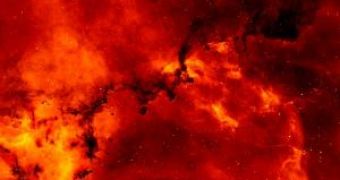The Milky Way, our home galaxy, a collection of more than 200 billion stars emitting light in all directions, is now being probed, in the hope that we will find more stars in their early stages of life, which would reveal how our own sun formed, and stars in the dawn of their lives that might share their secrets related to black holes, quasars or neutron stars.
The survey initiated by IPHAS studies the stars located in close proximity of our Sun, but also extremely distant objects, by capturing emissions given off by the hydrogen ions present in these objects, with the Issac Newton Telescope from La Palma. Among about 200 million objects that have been so far cataloged, there are incredible images of nebulae and stars shinning red light.
You might think that because hydrogen is the most abundant element in the universe, the method used by the scientists to find stars is inefficient. However, this is not the case, since the light emitted by hydrogen can actually provide more information about a given star, than any other observation method. Out of the studied stars, about one in a thousand is represented by stars that are at the end of their lives, about which we had very little information, before the use of the hydrogen ion emissions observations.
IPHAS released a catalogue, yesterday, containing the large collection of more than 5000 objects, in the hope that it will change the way astronomers currently share information. Also, the information has been published for online Internet access, by using the Virtual Observatory Interface, that can make comparisons with previously published catalogue to ensure accurate data.
This online interface has been specially built for the IPHAS in order to ensure an effective means of exploiting the data provided through observation made by the Isaac Newton Telescope, and has the target to probe more than 800 million objects.
Originally, the study was mostly concentrated on objects situated in the so-called Northern Plane of our galaxy, as seen from the surface of the Earth, using two colors and a sensitive filter necessary to observe the red spectrum emissions of Hydrogen (also called H-alpha emission). Though the probed region of the Milky Way first included only about 1600 square degrees, astronomers are hoping to extend the survey to more than 4000 square degrees, meaning that they would be able to cover the entire plane of the galaxy.
The images obtained from Hydrogen emissions have high enough resolutions to observe the emissions of separate stars, despite the diffuse glow of light emitted by high quantities of gas and dust forming nebulae, which surround the stars.
The results of the survey have already been put to use by astronomers from all over the word, like one of the members taking part in the study, which used the published information to classify the most brightest Hydrogen emissions of the stars present in the catalogue. Such classification can be used to create a map of so-called 'hot spots' that represent places in the galaxy where stars are actively being created.

 14 DAY TRIAL //
14 DAY TRIAL //